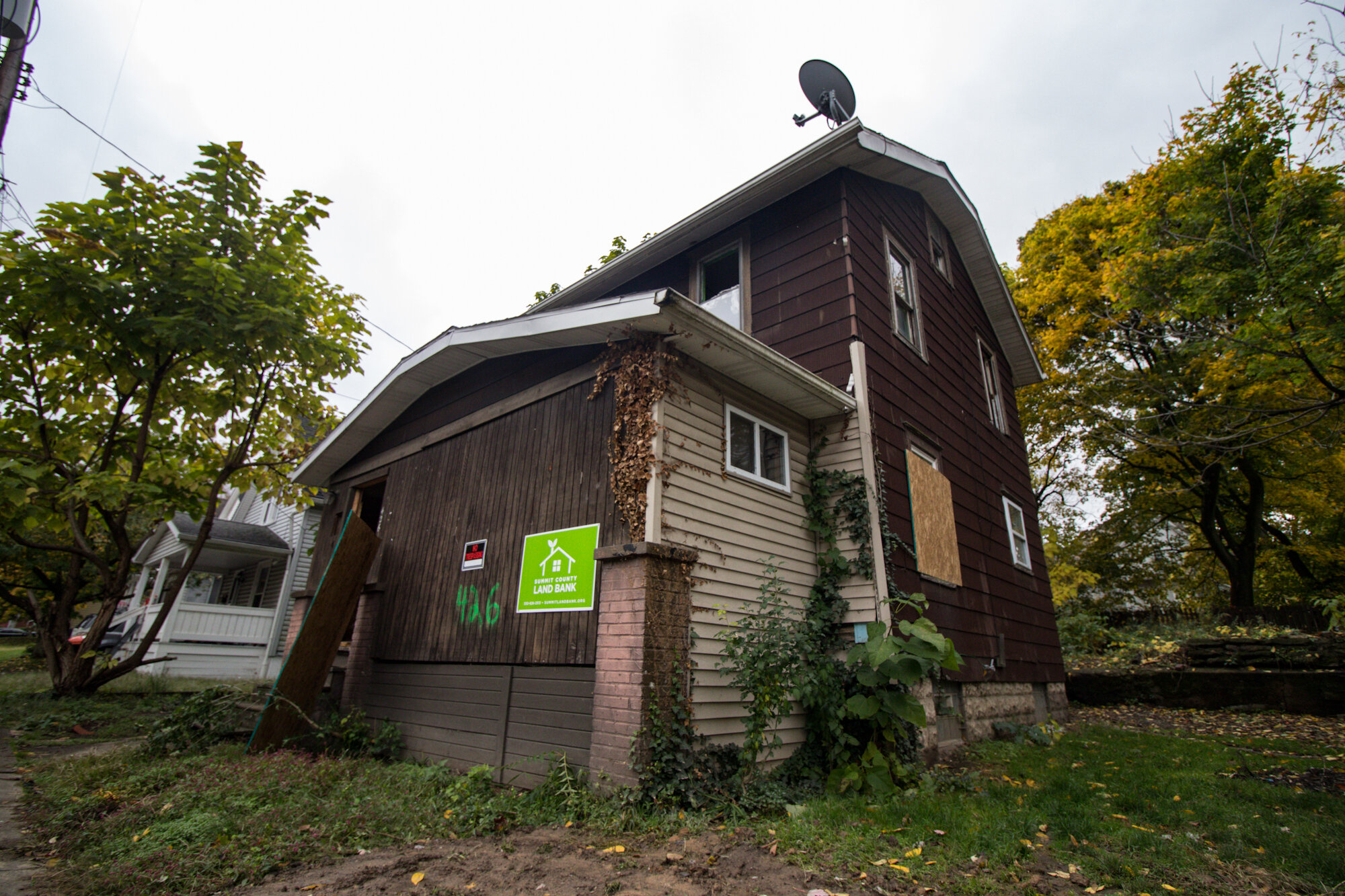A mother complained she had to bathe her 4-year-old in the kitchen sink because of mold in her bathtub.
A tenant recounted a story of contracting an illness from a rodent infestation that left her homeless.
Another expressed her hardships living in a building designed for older people and people with disabilities with elevators that kept breaking down.
These were among the stories shared at last week's City Council public comment session. Renters from four complexes serving marginalized groups — including low-income residents, chronically homeless, older adults and people with disabilities — gathered to share their experiences.
“It is a true act against humanity when it comes to the living spaces of people living in Akron,” Dee McCall, a community organizer for Freedom BLOC, a Black-led organizing collective working to assist marginalized groups with fair housing, told council members.
For over a month, tenants have appeared before council to share stories of their “unlivable” apartments.
As residents chronicled their stories of pests, mold and absent management, several council members expressed extreme concern and urged action to address “widespread” and “systemic” issues facing renters in the city.
“We really need you guys to help,” pleaded Edmikia Minter, a resident at Ericsson Apartments in East Akron.
Rodent infestation at Stoney Pointe Commons renders tenant homeless
Teneeka Hamilton moved into Stoney Pointe Commons in May 2020, excited by the prospect of having an apartment in a new building after living in her car and in hotels.
The 68-unit complex, owned by White Pond LLC and built in 2018, was designed to cater to the chronically homeless and people with disabilities. Each tenant receives a project-based voucher from Akron Metropolitan Housing Authority, and social services are offered in-house by Community Support Services.
But less than a month after moving into Stoney Pointe Commons, she said she contracted histoplasmosis, an infection caused by breathing in spores of bird, bat and rodent feces.
Hamilton said mice scurried across her bed as she tried to sleep, and she found droppings nearly everywhere in her apartment, including where she prepared food.
“I lost everything,” she told the Beacon Journal before she moved out on Jan. 21. “My furniture, my clothes, my health, my mind.”
Hamilton had to break her lease at the end of January with the help of AMHA and the building’s new management, ABC Management, which took over Jan. 1.
Devon Palmowski, ABC Management's director of operations, told the Beacon Journal they were unaware of the problem prior to the exchange of management and were treating the issue more aggressively.
"I cannot speak to whatever happened previously because I wasn’t there before [Jan. 1]," Palmowski said. "As far as ABC is concerned, we take these issues seriously, and we are always aiming for the health and safety of the residents. I’m sorry she left, and I wish it could’ve been rectified for her sooner."
Hamilton had to sleep in her car, where she had been living prior to moving into Stoney Pointe Commons, as she waited on a long list for a shelter bed.
Following publication of a Beacon Journal article, Freedom BLOC connected with Hamilton and paid for her to stay in a hotel while she searches for permanent housing with her AMHA voucher, though options are sparse.
But the group cannot and should not be the only ones helping, said McCall, whose work with Freedom BLOC has included assisting in forming tenant unions throughout the city. She said the organization is trying to unionize the residents at Stoney Pointe Commons to speak up about their living situation and demand more from the city, management and ownership.
“We really need to empower these folks to speak up for themselves,” she said. ”It’s hard because the people are discouraged because they feel like no one is listening or will help them. What we need in this city is to bring the people to the table for these decisions.”
Broken elevators leave older adults and people with disabilities stranded
Meanwhile, at White Pond Villa, a 48-year-old complex designed for older adults and people with disabilities, residents have suffered catastrophic effects of elevator shutdowns. An outage earlier this month resulted in four days without access to an elevator, and breakdowns are ongoing.
For residents, many of whom rely on mobility scooters, wheelchairs and canes, not having access to an elevator means missing doctor’s appointments, scrambling to get their medication or fearing what would happen if an emergency evacuation needed to occur.
For now, the owners installed a temporary part — a solution that is just a “band-aid fix,” said Akron Fire Department Capt. Michael Haas.
Duane Groeger, the city's housing administrator, said the owners are planning to replace the elevators in a process that will take between six to nine months.
“I don’t believe these owners are giving up on these elevators,” Groeger said. “I don’t believe a reasonable owner could say abandoning these elevators is even an option for a number of reasons.”
Issues with the elevators are hardly new, residents say. Deborah Holman, who has lived at White Pond Villa for six years, said she remembers problems ever since she moved in, along with other complaints.
There are four active case files among the 170 units, three of which have violations the owners have been ordered to correct, Groeger said. The fourth resident is working to schedule an inspection.
Groeger said attempts to reach the ownership have proved unsuccessful.
According to Summit County property tax records, the property is owned by New Jersey-based Apex White Pond L.P.
The complex is managed by a regional property manager Naftali Levenbrown, who did not respond to an email from the housing division prior to last week's meeting but spoke with the city on Feb. 2. Attempts by the Beacon Journal to reach him by phone and email were unsuccessful.
“This is not the first time we’ve talked about out-of-state property owners that are difficult to get ahold of,” Ward 8 Councilman Shammas Malik said. “The band-aid fix … the unresponsiveness; that’s all very frustrating because these property owners have a legal responsibility, but they also have a moral responsibility.”
Tenant Deborah Holman wants accountability now.
“I would like to see people be held accountable for their actions,” she said. “They’re making money off the residents knowing they’re not doing what they’re supposed to be doing as a landlord.”
She took matters into her own hands by forming a tenants association in 2020, though they have been unable to meet much throughout the pandemic. She plans to reinvigorate efforts this month in response to the elevator outages.
“Nobody should be living this way,” she said.
Tenants continue to organize against poor living conditions at two East Akron complexes
With the help of Freedom BLOC and Community Legal Aid, two housing complexes in East Akron, Wilbeth-Arlington Homes and Ericsson Apartments, formed tenant unions in October 2021 as renovations upended their already poor living situations.
Frequent ownership and management turnover have adversely affected residents of the low-income complexes, where tenants have long endured issues with roaches, rodents, mold, broken windows and doors and more.
After both properties were purchased by Texas-based Redwood Housing Partners in 2021, the company began $40 million in renovations to update each unit. In a presentation to City Council on Jan. 3, Redwood and KMG Prestige, which manages the properties, explained their renovation process and how they are addressing tenant complaints, including pest control, inspections and treatments.
“I certainly understand some of the concerns. The property was in poor condition,” Connie Mathes, the regional vice president and director of compliance at KMG Prestige, said during the presentation. “I think that we’ve done a lot to address their concerns. Do we have a long way to go? Absolutely.”
They said they plan to complete renovations by this summer.
Edmikia Minter, the president of Ericsson Apartments' tenant union, said she was moved into a renovated unit with her two children in November and found cockroaches her first night there. She said despite contacting management several times, pest control has never entered her apartment. In addition, a broken toilet she has complained about since December remains unfixed, leaking water she must regularly mop up.
Council President Margo Sommerville noted a recent visit where she saw a “brand-new window that was not installed properly” which caused “wind to blow in on a child sleeping in a bed right next to it.”
Ownership attributed those concerns to supply chain issues with procuring windows and said it should no longer occur. Additionally, they assured they were addressing problems as they come up.
Both Redwood and KMG representatives said they want to work with the tenant union and are meeting regularly with them.
“We want communications from our residents,” said KMG’s CEO Paul Spencer in the Jan. 3 presentation. “That’s the only way we can run a highly effective community … We really want to enhance people’s lives.”
Minter said Redwood and KMG contacted her for the first time in January, months after the unions were formed and complaints had been leveled. Leadership of both tenants unions now meet virtually with ownership and management every other week to bring forth ongoing complaints.
Minter said things still haven't changed.
"I feel like we repeating ourselves every two weeks, I swear," she said.
Redwood Housing Director Nick Boehm said in an email he understands tenants have suffered from "decades of underinvestment and/or mismanagement" that Redwood is "committed to reversing by raising the standard of living."
He said renovations go through several inspections before a tenant is moved in. An online resident portal also is being developed to submit work order requests directly to property management.
"Our primary goal is to raise the standard of living in the Akron community," he said. "We cannot do this alone and welcome any communication from the union(s).
Donnie Kammer, Ward 7’s council representative, said he is in weekly communication with Redwood and KMG.
In addition, Kammer, Ward 5’s Tara Mosley and at-large council member Jeff Fusco have attended meetings with the Department of Housing and Urban Development, Redwood and representatives from U.S. Sen. Sherrod Brown’s office.
How will Akron address rental issues?
Because these problems are systemic, Malik said, there’s “no quick fix.” Instead, he told the Beacon Journal, there needs to be a prolonged, sustained effort toward making housing more equitable in Akron.
Most immediately, he believes the city should use some of its $145 million in federal COVID relief dollars toward increasing staff within the housing division.
The city employs four inspectors and two supervisors in its housing division. With the city’s upcoming operational budget hearings in March, multiple council members have said they believe it would be an opportune time to hire additional inspectors, even temporarily using federal stimulus funds.
In addition, Malik recommended taking a closer look at the city’s housing code and making sure the enforcement “has teeth” with fines and repercussions in place.
In the cases of complexes with a high turnover in ownership such as Wilbeth-Arlington Homes or Ericsson Apartments, Ward 4 Councilman Russ Neal said he doesn’t think ownership should be allowed to change while there are active health and safety violations.
He also suggested excluding complexes with multiple violations from the city incentive programs, such as Akron’s 100%, 15-year property tax abatement program established in 2017. Any new builds that are beneficiaries should be held to a high standard, he said.
“To hear the stories week in and week out about circumstances that are so heartbreaking and so just unrelenting and to keep hearing these stories and to know these circumstances exist is to be called to do everything we can,” Ward 1 Councilwoman Nancy Holland said. “We have the ability to examine what can be done to assure that Akronites have access to safe housing and fair housing and an avenue of recourse when these things come up."
Published in the Akron Beacon Journal on Feb. 11, 2022.










































